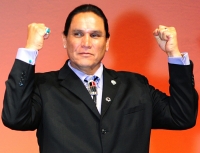
The National Indian Gaming Association was established 30 years ago by a small visionary group of tribal leaders. At the time—December 1985—contemporary Indian gaming had been active for more than 15 years, and this small group of tribal leaders saw the need to face legal and legislative challenges to protect the ability of tribal governments to use gaming to generate revenue to meet the severe unmet needs of native communities.
NIGA filled this void, providing Indian Country with a united voice in Washington, D.C. NIGA united behind the mission of protecting tribal sovereignty and promoting Indian gaming as a way to develop tribal economies. Our purpose was to educate legislators and the public about Indian gaming.
Back in the early 1980s, I was a kid playing basketball in our only gymnasium. I remember being frustrated when the court was closed to prepare for bingo games. I just wanted to play basketball, and I resented all these strange folks filling up our gym. Little did I know then that those bingo games were paying for the heat and lights so that I could play basketball.
Fulfilling the vision of tribal leaders that launched contemporary Indian gaming, our gaming revenues today fund tribal government programs that provide child care, elder care, language, culture, history programs, improved health care, energy assistance and much more. The early goal of paying the bills for essential utilities has grown much bigger.
This same story is true for so many tribes whose gaming operations began from these humble means. Because of Indian gaming, many native youth now have state-of-the-art gymnasiums, fitness centers, recreational and other programs to ensure their total well-being. These are just some of the ways that Indian gaming is working to reshape native communities nationwide.
Today, 245 tribal governments operate 445 gaming facilities in 28 states. Indian gaming revenues have reached $28.6 billion annually. This economic activity resonates through tribal communities and those of our neighbors, bringing economic success and prosperity to areas that had faced economic hardship.
For many tribes, Indian gaming is first and foremost about jobs. Indian gaming delivered over 665,000 direct and indirect American jobs in 2013 to both Indian and non-Indian employees. These jobs come with health insurance, dental and vision plans, retirement and life insurance—benefits that were unheard of in Indian Country prior to gaming. Indian gaming continues to be an American success story.
For years, tribes with gaming have operated ancillary businesses like hotels, restaurants, golf and gift shops and other gaming-related endeavors. Today, more tribes are investing and opening unrelated native ventures that provide all forms of services to Indian Country.
Economic development with and beyond gaming continues to be a major focus of our agenda. From something as simple as a local reservation grocery store to more complex business ventures related to improving community technology, manufacturing and agricultural production, these efforts are being undertaken to ensure the long-term economic security of tribal nations.
The aspect of this activity that I’m most excited about is it that it’s bringing our people home. Indian gaming is helping shape our next generation of native leaders. Gaming revenues are providing native youth with educational opportunities that were not previously available. After generations without a trained work force, Indian Country now has a talented pool of educated native professionals who are returning home to offer their expertise and contribute to the future success of their communities. This is true self-determination.
Over the past 30 years, tribes have used gaming dollars to improve tribal infrastructure, including the construction of roads, hospitals, schools, elder homes, police buildings and water systems. This development comes long overdue. For decades, our communities suffered with outdated and crumbling schools, hospitals and basic government service centers that threatened the health and physical safety of our people and visitors. Thanks in part to Indian gaming, many tribes now offer services in facilities that meet the growing needs of our communities.
Just recently, the Mississippi Choctaw Band of Indians held a grand opening for their new health center. The Choctaw Health Department serves more than 10,000 tribal citizens along with many more eligible Indians living in the area. The new $55 million facility now offers a full range of services that includes dental, vision, emergency medical services, physical therapy, a women’s wellness center and now, traditional native methods of healing.
As we come together for our annual trade show, we are excited about the new technology that will be on display and the networking and the business interactions that will take place on the trade-show floor.
The tribal membership meeting is another vital component of the trade show. Tribal leaders will put their minds together to evaluate local, state, regional and national issues to help develop NIGA’s legislative agenda for the coming year. Protection of all aspects of tribal sovereignty in this Congress and administration will be the main focus of the discussion.
It’s been decades since our most visionary tribal leaders launched the first Indian gaming operation to provide tribal governments with a means of achieving economic self-sufficiency. NIGA was established to protect this vision.
For 30 years, NIGA has stood strong, providing a unified voice to fulfill the mission of protecting and strengthening tribal sovereignty and the ability of tribes to use gaming as a means to provide for our people. Tribal government gaming has provided tremendous impacts for natives and non-natives alike.
We are proud of our legacy and all that it means to Indian Country today and for the next seven generations.






